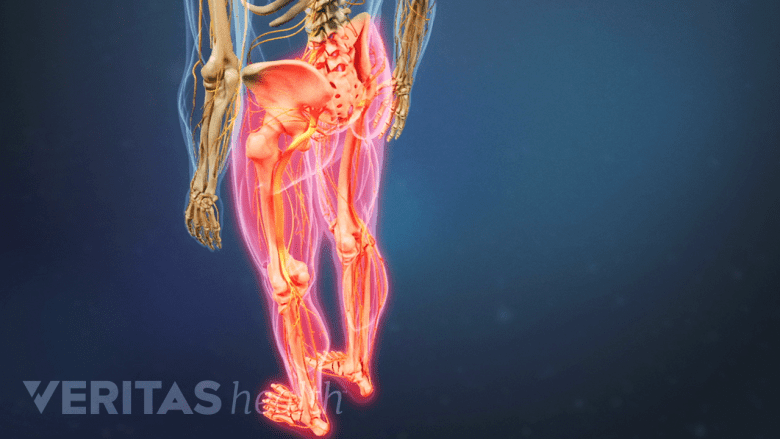When a concerning injury, symptom, or sign related to back pain occurs, it is important to make an immediate decision of how soon professional medical care is needed. The common options typically include:
- Calling the doctor’s office and discussing the problem with the doctor or nurse
- Going to urgent care or an immediate care facility
- Calling 911 and waiting for paramedic consult
- Going to the emergency room (ER)
While making this decision, it may also be important to consider the cost factor—an emergency room visit can cost several times more than visiting a physician.
Here are a few guidelines to help identify specific red-flag symptoms and signs related to back pain that provide information on deciding whether to go to the ER immediately, plan a visit to the urgent care, or wait for a doctor’s appointment later in the week.
In This Article:
- When Back Pain May Be a Medical Emergency
- Back Pain Red-Flags for Emergency Room vs. Physician Consults
When to Go to the ER for Back Pain

Sudden loss of sensation in the lower body is a medical emergency.
An ER visit is recommended when back pain indicates a medical emergency. An emergency is characterized by the probability of a serious adverse event or an incident that may result in a permanent disability. For back problems, the red-flag symptoms and signs that may indicate an emergency typically start suddenly and include some combination of the following:
- Sudden loss of sensation in one or both legs, the groin and genital area, and/or the anal region
- Inability to walk or stand
- Inability to control bowel movements
- Difficulty in passing urine or uncontrolled bladder movements
- Sudden, intolerable pain in the lower back and/or leg(s)
- Back pain that radiates to the abdomen in front
- Loss of consciousness
- Back pain that follows a trauma, such as a fall, sports injury, or car accident
- Sudden back pain with known risk factors for a fracture, such as osteoporosis
Many of these symptoms relate to spinal cord and/or cauda equina problems in the lower back, severe damage to a spinal nerve, or organ-related damage, or a possible fracture. It is important to evaluate and treat these symptoms and signs urgently to avoid permanent tissue damage and disability.
If any of the above symptoms are experienced, visiting the ER right away or calling 911 for assistance is advised.
When to Go to Urgent Care for Back Pain

Back pain with severe stiffness must be evaluated by a physician.
Certain back pain symptoms may not require immediate attention on the same day of occurrence but may need medical assessment as early as possible. When an appointment with a primary care physician or specialist is not available within a week, visiting an urgent care facility may be recommended to evaluate these symptoms:
- A recent increase in back pain that does not subside with over-the-counter or prescription medications
- Back pain associated with nausea and/or vomiting
- Back pain that becomes severe with specific movements, such as while coughing, bending forward or backward, or during twisting movements
- Back pain that travels down the hip and/or leg
- Recent onset of back stiffness
While an urgent care facility may not be equipped for a complete evaluation and diagnosis, the physician can help identify any hidden red-flag symptoms. An urgent-care physician can also prescribe medication to help control the symptoms in the short-term and offer referrals/guidance for further evaluation or treatment.
Waiting for a Doctor’s Appointment Later in the Week

Heat and cold therapy may help alleviate back pain by reducing inflammation.
If back pain is tolerable and does not cause alarming symptoms or signs, it may be safe to wait for a doctor’s appointment later in the week or by the following week. It is important not to ignore a back problem; evaluating and treating back pain at the earliest can help prevent the problem from becoming chronic. Chronic back conditions can be more challenging to treat.
Self-care tips for back pain relief at home
While waiting for a doctor’s appointment, following specific self-care measures can help prevent back pain symptoms from flaring. Effective self-care techniques that can be done at home, without a prescription, to address back pain flareups include:
- Trying over-the-counter oral and/or topical medication to relieve back pain
- Applying heat and cold therapy to reduce inflammation in the back
- Trying a therapeutic back massage to help improve blood circulation and healing
- Wearing a lumbar-stabilizing brace intermittently to limit excessive motion in the spine
Additional tip
With the recent increased availability of telehealth physician consultations, it may be possible to get a telehealth virtual visit with a primary care physician right away. These visits can help review the symptoms, concerns, and history with a virtual consult to help determine which type of follow-up medical visit is the optimal course of action.
It is also a good idea to make a note of the factors that aggravate back pain and those that help relieve the symptoms. An accurate history of when/how the pain started and the nature of the pain can help the doctor evaluate the underlying cause and provide an accurate diagnosis.

